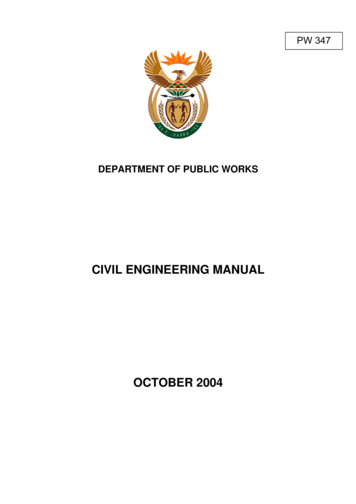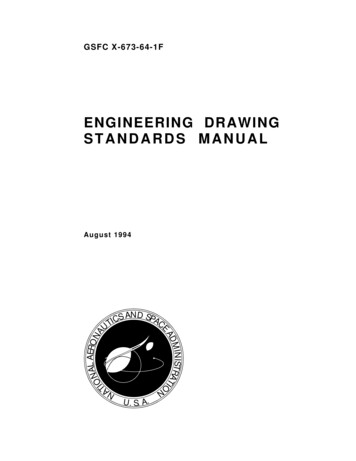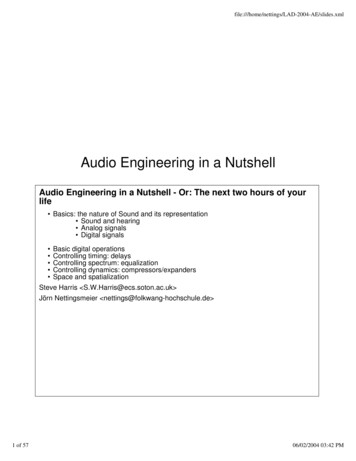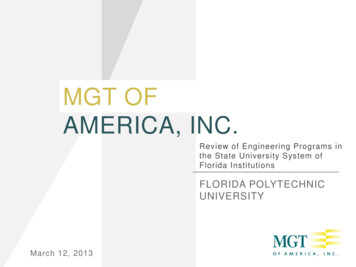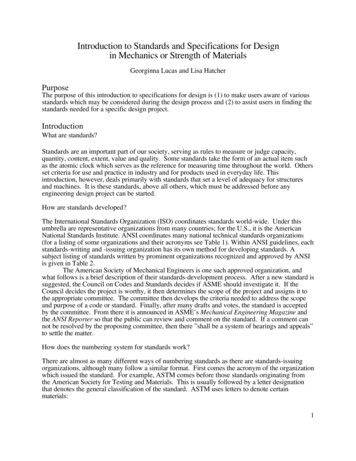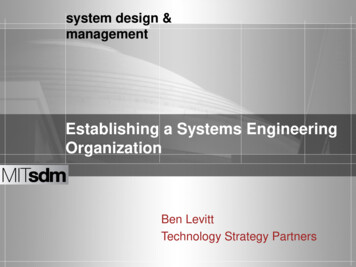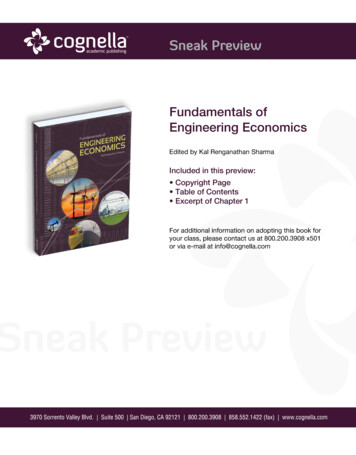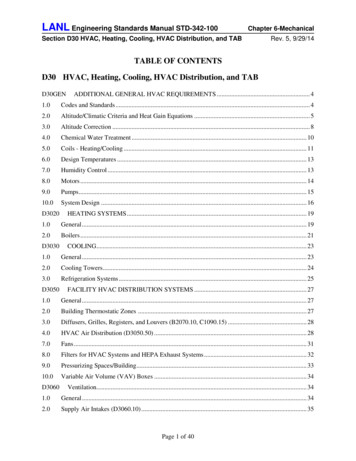
Transcription
LANL Engineering Standards Manual STD-342-100Chapter 6-MechanicalSection D30 HVAC, Heating, Cooling, HVAC Distribution, and TABRev. 5, 9/29/14TABLE OF CONTENTSD30 HVAC, Heating, Cooling, HVAC Distribution, and TABD30GENADDITIONAL GENERAL HVAC REQUIREMENTS . 41.0Codes and Standards . 42.0Altitude/Climatic Criteria and Heat Gain Equations . 53.0Altitude Correction . 84.0Chemical Water Treatment . 105.0Coils - Heating/Cooling . 116.0Design Temperatures . 137.0Humidity Control . 138.0Motors . 149.0Pumps . 1510.0System Design . 16D3020HEATING SYSTEMS . 191.0General . 192.0Boilers . 21D3030COOLING. 231.0General . 232.0Cooling Towers . 243.0Refrigeration Systems . 25D3050FACILITY HVAC DISTRIBUTION SYSTEMS . 271.0General . 272.0Building Thermostatic Zones . 273.0Diffusers, Grilles, Registers, and Louvers (B2070.10, C1090.15) . 284.0HVAC Air Distribution (D3050.50) . 287.0Fans . 318.0Filters for HVAC Systems and HEPA Exhaust Systems . 329.0Pressurizing Spaces/Building . 3310.0Variable Air Volume (VAV) Boxes . 34D3060Ventilation. 341.0General . 342.0Supply Air Intakes (D3060.10) . 35Page 1 of 40
LANL Engineering Standards Manual STD-342-100Chapter 6-MechanicalSection D30 HVAC, Heating, Cooling, HVAC Distribution, and TABRev. 5, 9/29/143.0Exhaust Air (D3060.30) . 354.0Testing, Adjusting, and Balancing (tab), D3060.90. 365.0Instrumentation and control, D3060.90 . 376.0Fume Hoods . 37D3070 Special Requirements for Nuclear-Safety-Related Ventilation and Air Treatment Systems(Programmatic and facility) . 37RECORD OF REVISIONSRevDateDescription06/28/99Chapter 6 rewritten and reformatted to support LIR220-03-01, FEM. Superseded Mechanical FacilitiesEngineering Standards, Volume 6, Manual RevisionNo. 15, dated COICDanny Nguyen,Dennis McLain,PM-2FWO-FEGeneral revision, split into Uniformat-basedsections, added endnotes. This LEM sectionreplaced FEM Subsections 204.2-.6, 204.20-.21,and 204.25. Added pump requirements, 420.1B.Tobin H. Oruch,Kurt Beckman,FWO-SEMFWO-SEMCombined D30GEN and D30 HVAC. Added full1993 climate data. Modified req’ts: general andhood altitude correction, eyewash for chemicaltreatment stations, coils, use of de-ionized water forhumidification, motor selection for fans. Madetable of standards broadly applicable; changed LEMto ESM. Gave POC authority on low NOx waivers.Added req’ts on direct-fired heater, 2-way valves,steam constants, mech room heat, boiler types andcontrol, relief air dampers, duct lining, independentTAB. Improved guidance on ceiling plenums, etc.Administrative changes only. IMP and ISD numberchanges based on new Conduct of Engineering IMP341. Master Spec number/title updates.Changed derating req’ts for fume hoods and localexhaust design, added design information for fumehoods, changed motor derating material, updatedTable D30GEN-2, added additional fan info, addedelectrical resistance heating requirements.DOE O 420.1C and G 420.1-1A updates, revisedduct detectors for 100 percent outside air, minoradmin and other changes.Charles DuPrè,Gurinder Grewal,FWO-DECSFWO-DOCharles DuPre,Kirk Christensen,FM&E-DESCENGCharles DupreLarry Goen,ES-DECENGMichael Ladach,Mel Burnett,ES-EPDCENGPage 2 of 40
LANL Engineering Standards Manual STD-342-100Section D30 HVAC, Heating, Cooling, HVAC Distribution, and TABChapter 6-MechanicalRev. 5, 9/29/14CONTACT THE MECHANICAL STANDARDS POCfor upkeep, interpretation, and variance issuesCh. 6, D30Mechanical POC and CommitteeThis document is online at http://engstandards.lanl.gov/Page 3 of 40
LANL Engineering Standards Manual STD-342-100Chapter 6-MechanicalSection D30 HVAC, Heating, Cooling, HVAC Distribution, and TABD30GENRev. 5, 9/29/14ADDITIONAL GENERAL HVAC REQUIREMENTSNote: Refer to the Mechanical Chapter Section D10-30GEN for general mechanical and HVACrequirements. General and HVAC piping requirements are in Section D20, Plumbing/Piping/Vessels(e.g., cross connection and expansion control, freeze protection, etc.).1.0CODES AND STANDARDSA.1.1Comply with the following codes and standards as well as others listed in D10-30GENand other applicable ESM sections.ACGIH (American Conference of Governmental Industrial Hygienists)A.Industrial Ventilation – A Manual of Recommended Practice for Design. 1NOTE: Many national standards are available for LANL here.1.2AHRI (Air-Conditioning, Heating and Refrigeration Institute)A.1.31.4http://ahrinet.org/ASHRAE (American Society of Heating, Refrigeration, and Air ConditioningEngineers)A.As a reference only: HVAC Handbooks.1B.Standard 15, Safety Code for Mechanical Refrigeration.1C.Standard 55, Thermal Environmental Conditions for Human Occupancy.D.Standard 62, Ventilation for Acceptable Indoor QualityE.Standard 90.1, Energy Standards for Buildings Except for Low Rise ResidentialBuildings.LANLA. Comply with all applicable LANL Master Specifications including:1.5NFPA (National Fire Protection Association)A.National Fire Codes and Standards (all except NFPA 5000).1Nationally recognized standards. Also, when systems exceed the temperature and pressure ratings of the UMC or UPC,nationally recognized standards are used per IAPMO UMC 2009, Section 1201.1 on hydronic piping.Page 4 of 40
LANL Engineering Standards Manual STD-342-100Chapter 6-MechanicalSection D30 HVAC, Heating, Cooling, HVAC Distribution, and TABB.Rev. 5, 9/29/14Listing of current NFPA codes and standards are also available at:http://www.nfpa.org/catalog/catalog home.asp?cookie test 11.62.0SMACNA (Sheet Metal and Air Conditioning Contractors National Association)A.HVAC Duct Construction Standards, Metal and Flexible. 1B.HVAC Systems, Duct Design. 1C.Seismic Restraint Manual, Guideline for Mechanical Systems 1D.Rectangular Industrial Duct Construction Standards. 1E.Round Industrial Duct Construction Standards. 1F.Guidance: Guide for Steel Stack Construction.G.Guidance: Fire, Smoke, and Radiation Damper Installation Guide for HVAC Systems.ALTITUDE/CLIMATIC CRITERIA AND HEAT GAIN EQUATIONSA.See Chapter 1 Section Z10 for altitude, latitude, barometric pressure, air density, and airdensity ratio values.B.Heating Degree-Days (annual mean): 6219 at 65 degrees F base; 2680 at 50 degrees Fbase. 2C.Cooling Degree-Days (annual mean): 2187 at 50 degrees F base, 272 at 65 degrees F base2D.Correct Q for altitude. Values for 7500 feet (suitable for many locations/situations) are:Q (sensible heat)(Btu/hr) 0.82 (@W 0) X cfm X t (at sea level 0.82 would be 1.08) 3Q (latent heat)(Btu/hr) 0.52 X cfm X W (gr.) (at sea level 0.52 would be 0.68) 3Q (total heat)(Btu/hr) 3.42 X cfm X h (at sea level 3.42 would be 4.50). 3Where:cfm Air flow Rate, cubic feet/min. W (gr) Humidity Ratio Difference, gr. water/lb. dry air. h Enthalpy Difference, Btu/lb. dry air.W Humidity Ratio, lb. water/lb. dry air. t Temperature Difference, degrees F.2LANL Calculation No. 00-0000-CALC-M-0006Sea level constants 1.08, 0.68, and 4.50, and equations are from 2005 ASHRAE Fundamentals Handbook, pages 29.16 and2013 ASHRAE Fundamentals Handbook. Constants have been corrected for 7500 foot conditions.3Page 5 of 40
LANL Engineering Standards Manual STD-342-100Section D30 HVAC, Heating, Cooling, HVAC Distribution, and TABE.Chapter 6-MechanicalRev. 5, 9/29/14Use Table D30GEN-1 local climate information for HVAC system sizing/design. It ispresented in the format of the 1993 ASHRAE Fundamentals Handbook, Load and EnergyCalculations Division, Weather Data Chapter 24. Refer to ASHRAE Handbook forexplanation of columns and acronyms. [Guidance: 1994-2003 data (both I-P and S-Iunit) for energy usage predictions (not sizing) is available from the Mechanical POC ordirectly from LANL Calculation 00-0000-CALC-M-0006.].Page 6 of 40
LANL Engineering Standards Manual STD-342-100Chapter 6-MechanicalSection D30 HVAC, Heating, Cooling, HVAC Distribution, and TABRev. 5, 9/29/14TABLE D30GEN-1Climatic Conditions for the United States (from ASHRAE Fundamentals 1993 Weather Data Table 1)Winter, deg FCol. 1Col. 2Col. 3Col.4State/StationLat.Long.Elev.degNew MexicoLos Alamos4NdegWFeetSee4noteCol. 5DesignDry-BulbSummer, deg FCol. 6Design Dry Bulb andWetMean CoincidentBulbCol. 7MeanCol. /6087/6085/6032626160Page 7 of 40Temp, deg FCol. 9Col. 10Median ofWinter99%Use ESM Chapter 1 Section Z10 ConstantsPrevailing WindSummerKnotsAnnual Extr.Max.Min.89.8-2.3
LANL Engineering Standards Manual STD-342-100Section D30 HVAC, Heating, Cooling, HVAC Distribution, and TAB3.03.13.2Chapter 6-MechanicalRev. 5, 9/29/14ALTITUDE CORRECTIONA.Guidance: At LANL’s altitude, the air pressure and density is lower than at sea level, thecondition for which HVAC equipment is designed/rated. Therefore, HVAC equipmentoperating at LANL produces less than its catalog rating. Correcting for this duringdesign is required so that procurement of appropriately larger equipment occurs. Thus,in the procurement spec that’s developed after the sizing calculations, this largerequipment should be specified, knowing it will be adequately sized when operating atLANL altitude. The spec should either (1) be clear that output ratings are alreadyadjusted for altitude and should not be further adjusted by the vendor, or (2) leavecorrection up to the vendor (e.g., “Achieve XXX Btu/hr at 7500 feet”). If the correctionhas been made and captured in the specification’s data, then the procurement specshouldn’t also say something like “equipment provided be sized for LANL altitude,”since this could result in a doubly-corrected outcome.B.Ideally, only the calculated actual operating parameters (capacity, static pressure,cooling/heating loads) required at 7500 ft elevation should be shown on the designdrawings and in the technical specifications. Only a statement such as "ALLCAPACITIES SHOWN OR INDICATED ARE AT 7500 FT ELEVATION" should beincluded in the drawings or specifications. It should be the responsibility of theContractor or the equipment manufacturer to make the needed adjustments to theirequipment to meet the requirements at the 7500 ft elevation. The equipmentmanufacturer should be asked to provide submittal (fan curves, performance data) toback up their selection.FansA.Correct catalog data before applying it at LANL’s 7,500 foot altitude. Guidance: Failureto correct for altitude will result in undersized equipment. An increase in altitude meansa decrease in air density and barometric pressure. Air moving equipment is rated andcataloged at sea level (standard air density 0.075 pcf at 70 degrees and 29.92 inches Hgbarometric pressure)B.Guidance: Fans are constant volume devices and therefore air density has no effect onthe volume delivered; however, it does affect the motor horsepower, static pressure, andmass flow rate.Fan Selection Procedure at 7,500 Foot Altitude (Guidance)A.Determine the actual volumetric flow rate (acfm) at 7500 feet.B.Using this actual flow rate (acfm) and standard air (sea level) friction data to design theductwork, calculate the system static pressure at sea level.C.Select the fan by referring to sea level fan capacity tables and using the actual cfmrequired at altitude and the system static pressure calculated at sea level. The rpmshown in the tables is the rpm at which the fan must operate and need not be corrected.Page 8 of 40
LANL Engineering Standards Manual STD-342-100Chapter 6-MechanicalSection D30 HVAC, Heating, Cooling, HVAC Distribution, and TABD.Rev. 5, 9/29/14Correct the static pressure and brake horsepower (bhp) shown in the fan tables toaltitude conditions by dividing these values by the air density ratio at 7,500 feet (nominal1.32 at 70 degree F). This yields the static pressure that the fan will produce at altitudeand the BHP required at altitude. Refer to Table D30GEN-2 when installationenvironment involves non-standard temperatures at 7,500 feet elevation.TABLE D30GEN-2 2Air Density Correction Factor at 7,500 Feet E.3.3Air Density Ratio1.151.251.291.301.311.32 (Nominal)1.351.361.371.391.401.451.50High Temperature: Exercise caution in selecting the motor sizes for operating fanshandling high temperature air. If a fan system designed to operate with high temperatureair is started when the system is cold, the fan will require more horsepower during startup; therefore, the motor size should be selected for cold starting.Air Conditioning and Refrigeration Equipment, 70.0550.0550.0540.0540.0540.0520.050Derate air-cooled equipment (e.g., chillers, coils, condensers, cooling towers, VAVs,VFDs) for altitude. Guidance: Consult with manufacturer and the following publicationsfor derating data:1.Carrier: Engineering Guide for Altitude Effects.2.Trane: Effects of Altitude on Air Conditioning Equipment.Fume Hood and Local Exhaust DesignA.The exhaust airflow from fume hoods and other local exhaust systems such as weldingbenches, snorkels, and open surface tanks must be determined carefully. Capturevelocities and face velocities shall be as recommended in the latest ACGIH, IndustrialVentilation – A Manual of Recommended Practice for Design. The cfm/ft² or fpm valuesgiven shall be taken to mean acfm/ft² or fpm at altitude. When a range of capturevelocities is given, the upper end of the range shall be chosen.Page 9 of 40
LANL Engineering Standards Manual STD-342-100Chapter 6-MechanicalSection D30 HVAC, Heating, Cooling, HVAC Distribution, and TAB3.53.6Gas-Fired EquipmentA.Determine natural gas consumption (cfh) by dividing the Btu/h input rating at sea levelby the gas heating value of 1000 Btu/ft3. 5B.Derate gas-fired heating units and atmospheric boilers catalog output rating by 30percent. 6C.Specify gas fired units that will be operating at 7500 feet altitude (see Chapter 1, Z1010Constants, for altitude exceptions) so the manufacturer can factory install the correct gasorifices.D.For forced-draft boilers, consult with manufacturer for derating criteria.MotorsA.4.0Rev. 5, 9/29/14Refer to the Motors subsection below for deration and selection criteria.CHEMICAL WATER TREATMENTA.Clean, flush, and chemically-treat process water in HVAC systems, e.g., steams, hotwater, heating, cooling systems, etc. to address LANL’s higher-than-neutral pH and silicascaling problems.1.Consult the ESM Mechanical POC for specific requirements, such as type oftreatment system, chemicals, etc. For existing facilities the LANL SystemEngineer will be consulted to determine preferred chemicals.B.Provide biocide products that are registered with the EPA, with the registration numberclearly shown on the drum.C.Chemical supplier personnel using biocide products shall have a New MexicoDepartment of Agriculture (NMDA) pesticide applicator license.D.Chemical formulations used in water treatment require LANL Water Quality Group(ENV-RCRA) approval. 7E.Provide an emergency eyewash per OSHA 10CFR 1910.151 and 1450 if required after anevaluation/analysis by LANL IHS-IP. Consult IHS-IP Industrial Hygiene and Safety foradditional emergency equipment requirements.1.Guidance Note: Potable eye station may be acceptable in lieu of permanent.5Per LANL Utilities & Infrastructure Group Gas Representative, “By contract, the gas supplier must furnish natural gas with aminimum heating value of 1,000 btu/ft3.”6Carrier publication “Engineering Guide for Altitude Effects.” (derate 4 percent for each 1,000 feet above sea level.) (EMref-9)7The LANL Water Quality Group (ENV-RCRA) is responsible for submittal of compliance data to the EPA and NMED asrequired for NPDES permits.Page 10 of 40
LANL Engineering Standards Manual STD-342-100Chapter 6-MechanicalSection D30 HVAC, Heating, Cooling, HVAC Distribution, and TABF.Rev. 5, 9/29/14Refer to the following LANL Engineering Standards: 81.Mechanical Drawing(s) ST-D3030-1, Cooling Tower and Chiller PipingComponent Diagram2.Mechanical Drawing(s) ST-D30GEN-1, Open Cooling Tower Water Treatment.3.Master Specification 23 2500, HVAC Water Treatment.5.0COILS - HEATING/COOLING5.1GeneralA.Provide Air Conditioning and Refrigeration Institute (ARI)-certified heating and coolingcoils for central station HVAC units and field built-up systems.13B.For coil selection, use a manufacturer’s computerized selection program to facilitateselection for the most energy efficient system, and to obtain the coil rated performancedata in accordance with AHRI Standard 410, Forced-Circulation Air-Cooling and AirHeating Coils, Table 1, Range of Standard Rating Conditions. http://ahrinet.org1.Guidance: Limit dry (sensible) cooling coils to 575 fpm air face velocity.2.Guidance: Limit heating coils to 750 fpm air face velocity.C.For HVAC applications, except outside air preheat coils, use a minimum tube watervelocity of 2 fps. 9D.Limit air velocities of wet coils (these both cool and dehumidify) to values that preventwater carryover into the ductwork.1.Guidance: For comfort applications, wet coils are frequently selected in therange of 400-500 fpm air face velocity. 10E.Provide coils with copper tubing and aluminum fins where coil selection and designpressures permit. 11F.Provide sloped stainless steel drip pans when installing cooling coils in built-up systemswith intermediate condensate pans at each tier and interconnecting drain piping. Providean approved P-trap at drip pan and pipe drip pans to floor drains. 121.G.Guidance: For best indoor air quality choice, slope drip pans in 2 directions.Properly size and configure condensate traps in accordance with the UMC 11 and themanufacturers’ recommendations.138The drawings and specification provide piping details, additional design guidance, and specifications for equipment andchemicals.92012 ASHRAE HVAC Systems and Equipment Handbook, Air Conditioning and Dehumidifying Coils102012 ASHRAE HVAC Systems and Equipment Handbook, Performance and Ratings11Most common combination (industry standard)12IAPMO UMC 2009, Section 30913Trane Catalog CLCH-DC-7, Central Station Air Handlers, Application Considerations, recommended procedures for sizingcondensate trap piping (EMref-13)Page 11 of 40
LANL Engineering Standards Manual STD-342-100Chapter 6-MechanicalSection D30 HVAC, Heating, Cooling, HVAC Distribution, and TAB5.2Rev. 5, 9/29/14H.Guidance: Use hot water for final heating coils. 14I.Refer to the following LANL standard drawings for additional requirements: 151.Mechanical Drawing(s) ST-D30GEN-2, Water Coil Piping.2.Mechanical Drawing(s) ST-D30GEN-3, Steam Coil Piping.Preheat CoilsA.B.General1.Building air handling units shall include a preheat coil upstream of chilled wateror hot water reheat coils. The preheat coil shall be sized to heat building frominitial 40 degrees to 55 degrees within one hour while maintaining minimumoutside airflow requirements (for buildings with automation systems, theadditional capacity to provide for minimum outside air requirements is notnecessary if outside air dampers will be closed during warm-up). 162.Operate face and bypass coils with constant steam or water flow. Do notmodulate flow.3.Provide a sensor in the discharge air stream to maintain a constant discharge airtemperature, regardless of variations in inlet air temperature.Design1.Design coils for an entering air temperature of minus 10 degrees F for 100percent outside air systems. For steam coils, oversize condensate return piping tohandle large condensate flow at startup.172.Provide supply air preheat coils, using hot water or low pressure steam, with thenecessary controls, etc., to protect them from freezing. The following areacceptable systems:a.Hot water coil with circulating pump to maintain a minimum coil watervelocity of 4 fps. Refer to Mechanical Standard Drawing ST-D30GEN-2,Hot Water Coil – Constant Flow, Fail to Full Heat.b.Vertical tube integral face and bypass steam or water coils with clamshelltype dampers to control airflow. 1814Electric coils have a high operating cost that offsets any low initial cost. Steam coils are hard to control and require moremaintenance than hot water coils.15The coil piping details provide piping details for different applications and additional design requirements.16Basis: Preheat enables reasonable time for cold weather startup and restart. Buildings would not be expected to drop below 40deg since space heaters or the like would be deployed; similarly, above 55 degrees the reheat coils would continue warm-up.Lessons learned from MST Office Building.17Entering air design temperature based on lessons learned and historical climatic conditions.18Integral face and bypass coils are used as a freeze protection measure. The temperature of the discharge air is controlled byproportioning entering air through the multiple heating and bypass channels of the face and bypass coils. The air is proportionedby clamshell-shaped dampers, which maintain a constant pressure drop, thus allowing a constant volume of air to pass throughthe unit.Page 12 of 40
LANL Engineering Standards Manual STD-342-100Section D30 HVAC, Heating, Cooling, HVAC Distribution, and TABc.DESIGN TEMPERATURES6.1OutdoorA.Winter: 5 degrees F dry bulbB.Summer: 89 degrees F dry bulb, 60 degrees F wet bulbIndoor (Dry-Bulb) 19A.B.C.7.0Rev. 5, 9/29/14Steam coil with properly designed control valve, steam trap with checkvalve, and vacuum breaker. Follow ASHRAE HVAC Systems andEquipment Handbook, Steam Systems.6.06.2Chapter 6-MechanicalCooling:1.General Comfort: 75 degrees F.2.Mechanical/Electrical Rooms: Refer to ESM Mechanical Section D30,Ventilation.Heating:1.Office/Laboratories: 72 degrees F (general comfort)2.Mechanical Rooms: 50 degrees F3.Storage Space (unoccupied): 55 degrees F4.Warehouses: 50 degrees F5.Kitchens: 60 degrees F6.Change Rooms: 75 degrees FNote: Program requirements may require different indoor design temperatures.HUMIDITY CONTROLA.Provide humidity control only when programmatic requirements specify humidity levelsin a zone or zones (e.g., in computer or explosive areas to prevent the buildup of staticelectricity).1.Comply with ASHRAE Standard 55, Thermal Environmental Conditions forHuman Occupancy. 202.Provide humidity monitoring system to automatically adjust building conditionsas appropriate.2019The heating and cooling design temperature for general comfort is within the acceptable ranges of ASHRAE Standard55-2004, Figure 5.3.1. The remainder of the heating temperatures is based on previous designs.20Provides for a thermally comfortable environment that supports the productive and healthy performance of the buildingoccupants. Compliance meets LEED Rating System 2.0 (2 points), Indoor Environmental Quality - Thermal Comfort.Page 13 of 40
LANL Engineering Standards Manual STD-342-100Chapter 6-MechanicalSection D30 HVAC, Heating, Cooling, HVAC Distribution, and TAB3.B.Guidance: Humidity Control is typically not practical for general comfortbecause of the dry climate in Los Alamos.Provide vapor barriers in spaces requiring humidity control to prevent moisture migrationand condensation in the thermal insulation.1.Humidification: Provide barrier on inside wall surfaces.2.Dehumidification: Provide barrier on outside wall surfaces.C.When humidity is added to a space, provide an analysis (to prevent condensation) onwhere dew point temperatures will occur for exterior walls, roofs, and windows.D.Provide humidification units with deionized water; Mechanical POC and FOD approvalrequired for other sources. 21 Consult with humidifier representative for water qualityrequirements (conductivity in micro-ohms).E.When using boiler steam for humidification, provide a steam-to-steam converter. 22F.When using a mechanical cooling system for dehumidification, install the heating coildownstream of the cooling coil to provide reheat.1.8.0MOTORS8.1Derating8.2Rev. 5, 9/29/14Guidance: A preheat coil may be required to prevent freezing the chilled watercoil in the winter. See Coils subsection above.A.Pumps: Do not overload altitude-derated motors at any point on the pump curve.B.Fans: Do not overload altitude-derated motors beyond the design operating conditions ofthe fan curve.C.General: Follow ESM Electrical Chapter 7, Section D5020.EnclosuresA.Provide open drip-proof (ODP) motors for clean, dry indoor locations.B.Motors that are part of factory-assembled equipment and are located in the air streammay be either totally enclosed non-ventilated (TENV) or totally enclosed fan-cooled(TEFC).C.Provide TEFC motors for outdoor applications and for indoor applications in damp ordusty locations.21Tap water at LANL is high in silica and scale deposits will cause operational and maintenance issues. DI systems containscale in vessels relatively easy to change/maintain.22Steam boilers are chemically treated and the chemicals used for treatment are most likely not suitable for breathing air.Page 14 of 40
LANL Engineering Standards Manual STD-342-100Section D30 HVAC, Heating, Cooling, HVAC Distribution, and TAB8.39.02425Rev. 5, 9/29/14D.Provide severe duty TEFC motors in wash-down locations or corrosive locations such asdraw through cooling towers.E.In hazardous locations use explosion-proof motors that are UL labeled for the locationhazard classification.SelectionA.For motor selection, refer to motor selection chart (Minimum Full Load Efficiency andMaximum Load) in LANL Master Specification 26 0700, Induction Motors – 500HP andSmaller. 23B.General: Follow ESM Electrical Chapter 7, Section D5020.PUMPSA.Design and calculate the net positive suction head (NPSH) available in piping systemsand ensure that the NPSH required (found on pump curve) is less than the NPSHavailable.B.Pumps shall be accessible for maintenance.C.Secondary pump containment (metal pan, angle iron barrier, etc.) may be required forsystems handling caustic, contaminated, etc., fluids. Consult with the area ENV or IHSrepresentative or customer for requirements.D.Provide a steam-powered pump when condensate must be moved to a higher elevation orgreat distances. 241.23Chapter 6-MechanicalIf an electrical-powered condensate pump must be specified, provide an isolat
General revision, split into Uniformat-based sections, added endnotes. This LEM section replaced FEM Subsections 204.2-.6, 204.20-.21, and 204.25. Added pump requirements, 420.1B. . A. Comply with the following codes and standards as well as others listed in D10-30GEN and other appli


